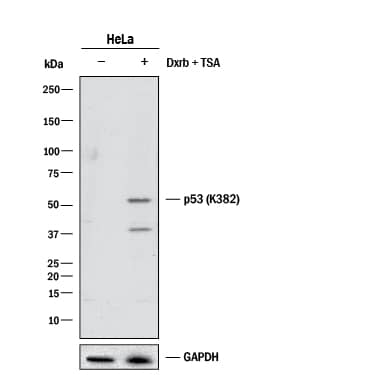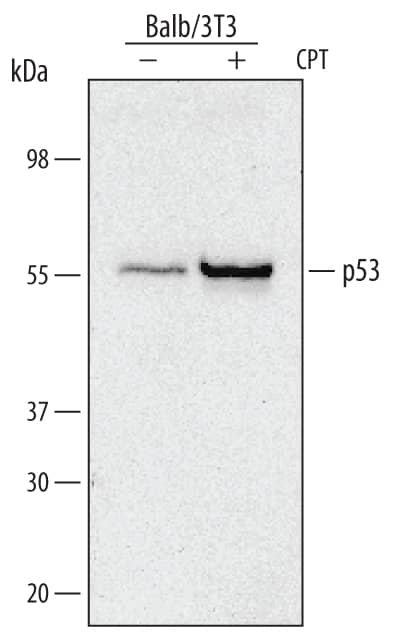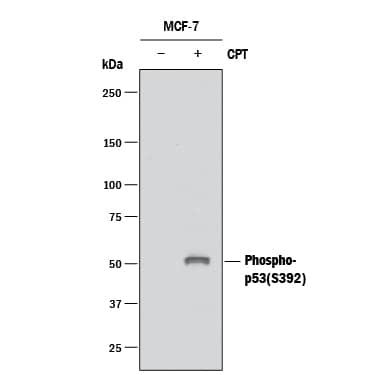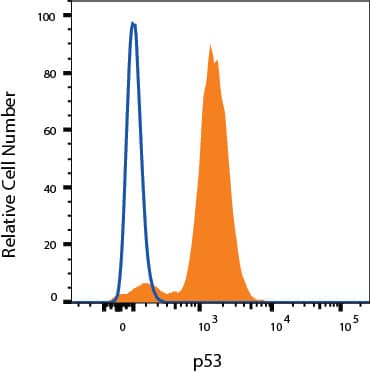p53: Antibodies
Bio-Techne offers high quality p53 antibodies from our Novus Biologicals and R&D Systems brands. Our p53 antibodies have been cited in 159 publications with 16 5-star customer reviews. Browse our catalog for anti-p53 monoclonal, polyclonal, and recombinant monoclonal antibodies. These antibodies are reactive in target species including Human, Mouse, Rat, Monkey, Bovine, and more. Our p53 antibodies have been validated for use in several research applications: Simple Western, Knockout Validated, Knockdown Validated, Immunohistochemistry, Western Blot, and more. Choose the anti-p53 antibody best suited for your research needs by viewing the technical details, images, citations, reviews, and more. Each p53 antibody is fully covered by Bio-Techne’s 100% guarantee.
Bio-Techne offers a comprehensive range of other p53-related products including p53 Proteins and Enzymes, p53 ELISA Kits, and more.
1095 results for "p53 Primary Antibodies" in Products
1095 results for "p53 Primary Antibodies" in Products
p53: Antibodies
Bio-Techne offers high quality p53 antibodies from our Novus Biologicals and R&D Systems brands. Our p53 antibodies have been cited in 159 publications with 16 5-star customer reviews. Browse our catalog for anti-p53 monoclonal, polyclonal, and recombinant monoclonal antibodies. These antibodies are reactive in target species including Human, Mouse, Rat, Monkey, Bovine, and more. Our p53 antibodies have been validated for use in several research applications: Simple Western, Knockout Validated, Knockdown Validated, Immunohistochemistry, Western Blot, and more. Choose the anti-p53 antibody best suited for your research needs by viewing the technical details, images, citations, reviews, and more. Each p53 antibody is fully covered by Bio-Techne’s 100% guarantee.
Bio-Techne offers a comprehensive range of other p53-related products including p53 Proteins and Enzymes, p53 ELISA Kits, and more.
| Reactivity: | Human, Mouse, Rat, Yeast, Xenopus (Negative) |
| Details: | Mouse IgG1 kappa Monoclonal Clone #PAb 240 |
| Applications: | IHC, WB, ELISA, ICC/IF, Flow, +2 More |
| Reactivity: | Human, Mouse, Rat |
| Details: | Goat IgG Polyclonal |
| Applications: | WB, Simple Western, IP, ChIP, ICC, +1 More |
| Reactivity: | Human |
| Details: | Rabbit IgG Polyclonal |
| Applications: | WB, IHC, IP, ICC |
| Reactivity: | Human |
| Details: | Rabbit IgG Polyclonal |
| Applications: | IHC, WB, Flow, IP, ChIP, +1 More |
| Reactivity: | Human, Mouse, Rat, Yeast, Xenopus (Negative) |
| Details: | Mouse IgG1 kappa Monoclonal Clone #PAb 240 |
| Applications: | IHC, WB, ELISA, ICC/IF, Flow, +2 More |
| Reactivity: | Human, Mouse, Rat |
| Details: | Mouse IgG2b Monoclonal Clone #184721 |
| Applications: | WB, IP, ICC |
| Reactivity: | Human, Mouse, Rat |
| Details: | Goat IgG Polyclonal |
| Applications: | WB |
| Reactivity: | Human, Mouse, Monkey, Rabbit |
| Details: | Mouse IgG1 Monoclonal Clone #OTI5E2 |
| Applications: | IHC, WB, ICC/IF, Flow, Simple Western |
Recombinant Monoclonal Antibody.
| Reactivity: | Human, Mouse, Rat, Monkey, Rabbit |
| Details: | Rabbit IgG Kappa Monoclonal Clone #PAb421 |
| Applications: | IHC, WB, ELISA, ICC/IF, Flow, +2 More |
| Reactivity: | Human, Monkey, Bovine |
| Details: | Mouse IgG2a Kappa/IgG2b Kappa Monoclonal Clone #BP53-12 + DO-7 |
| Applications: | IHC, WB, ICC/IF, Flow, CyTOF-ready |
| Reactivity: | Human |
| Details: | Rabbit IgG Polyclonal |
| Applications: | WB, Simple Western, IHC |
| Reactivity: | Human, Mouse |
| Details: | Rabbit IgG Polyclonal |
| Applications: | IHC, WB, ICC/IF, IP |
Recombinant Monoclonal Antibody.
| Reactivity: | Human |
| Details: | Rabbit IgG Monoclonal Clone #TP53/1799R |
| Applications: | IHC, WB, ICC/IF, Flow, MA |
Recombinant Monoclonal Antibody.
| Reactivity: | Human |
| Details: | Rabbit IgG Monoclonal Clone #2589A |
| Applications: | WB, IHC, ICC |
| Reactivity: | Human, Mouse, Monkey |
| Details: | Mouse IgG1 Monoclonal Clone #OTI5E2 |
| Applications: | IHC, WB, ICC/IF, Flow, CyTOF-ready, +1 More |
| Reactivity: | Human |
| Details: | Mouse IgG1 Monoclonal Clone #CL2199 |
| Applications: | IHC, WB, ICC/IF, Mycoplasma, Simple Western, +1 More |
| Reactivity: | Human, Monkey, Bovine |
| Details: | Mouse IgG2b Kappa Monoclonal Clone #DO-7 |
| Applications: | IHC, WB, Simple Western |
| Reactivity: | Mouse |
| Details: | Rat IgG2b Monoclonal Clone #197643 |
| Applications: | IP |
| Reactivity: | Human, Mouse, Rat |
| Details: | Goat IgG Polyclonal |
| Applications: | WB |
| Reactivity: | Human |
| Details: | Rabbit IgG Monoclonal Clone #2185A |
| Applications: | WB, ICC |
Recombinant Monoclonal Antibody.
| Reactivity: | Human |
| Details: | Rabbit IgG Monoclonal Clone #TP53/1799R |
| Applications: | IHC, WB, ICC/IF, Flow, CyTOF-ready, +1 More |
| Reactivity: | Human |
| Details: | Mouse IgG2b Monoclonal Clone #184727 |
| Applications: | CyTOF-ready, ICFlow |
| Reactivity: | Human |
| Details: | Rabbit IgG Polyclonal |
| Applications: | WB, IHC |
| Reactivity: | Human, Mouse, Rat |
| Details: | Mouse IgG2b Monoclonal Clone #184721 |
| Applications: | WB, IP, ICC |
| Reactivity: | Human |
| Details: | Mouse IgG1 Monoclonal Clone #CL2199 |
| Applications: | IHC, WB, ICC/IF, Simple Western |

![Western Blot: p53 Antibody (PAb 240)BSA Free [NB200-103] Western Blot: p53 Antibody (PAb 240)BSA Free [NB200-103]](https://resources.bio-techne.com/images/products/p53-Antibody-PAb-240-Western-Blot-NB200-103-img0001.jpg)



![Western Blot: p53 Antibody [NB200-171] Western Blot: p53 Antibody [NB200-171]](https://resources.bio-techne.com/images/products/p53-Antibody-Western-Blot-NB200-171-img0076.jpg)
![Western Blot: p53 Antibody (PAb 240)Azide and BSA Free [NBP2-80898] Western Blot: p53 Antibody (PAb 240)Azide and BSA Free [NBP2-80898]](https://resources.bio-techne.com/images/products/p53-Antibody-PAb-240-Azide-and-BSA-Free-Western-Blot-NBP2-80898-img0001.jpg)


![Western Blot: p53 Antibody (OTI5E2) [NBP2-00723] Western Blot: p53 Antibody (OTI5E2) [NBP2-00723]](https://resources.bio-techne.com/images/products/p53-Antibody-5E2-Western-Blot-NBP2-00723-img0018.jpg)
![Western Blot: p53 Antibody (PAb421)ChimericAzide and BSA Free [NBP2-62555] Western Blot: p53 Antibody (PAb421)ChimericAzide and BSA Free [NBP2-62555]](https://resources.bio-techne.com/images/products/p53-Antibody-PAb421-Chimeric-Western-Blot-NBP2-62555-img0003.jpg)
![Immunohistochemistry-Paraffin: p53 Antibody (BP53-12 + DO-7) - Azide and BSA Free [NBP2-34563] Immunohistochemistry-Paraffin: p53 Antibody (BP53-12 + DO-7) - Azide and BSA Free [NBP2-34563]](https://resources.bio-techne.com/images/products/p53-Antibody-BP53-12-+-DO-7-Azide-and-BSA-Free-Immunohistochemistry-Paraffin-NBP2-34563-img0001.jpg)

![p53 antibody [N1], N-term detects p53 protein at nucleus by immunofluorescent analysis.<br></br>Samples: HCT 116 cells mock (left) and treated with 30 uM Cisplatin for 24 hrs (right) were fixed in 4% paraformaldehyde at RT for 15 min.<br>Green: p53 protein stained by p53 antibody [N1], N-term.<br>Blue: Hoechst 33342 staining.<br>Scale bar = 10 um.](https://resources.bio-techne.com/images/products/p53-Antibody-Western-Blot-NBP2-19667-img0006.jpg)
![Western Blot: p53 Antibody (TP53/1799R) [NBP2-59631] Western Blot: p53 Antibody (TP53/1799R) [NBP2-59631]](https://resources.bio-techne.com/images/products/p53-Antibody-TP53-1799R-Western-Blot-NBP2-59631-img0005.jpg)

![Western Blot: p53 Antibody (OTI5E2)Azide and BSA Free [NBP2-73200] Western Blot: p53 Antibody (OTI5E2)Azide and BSA Free [NBP2-73200]](https://resources.bio-techne.com/images/products/p53-Antibody-OTI5E2-Azide-and-BSA-Free-Western-Blot-NBP2-73200-img0002.jpg)
![Immunohistochemistry-Paraffin: p53 Antibody (CL2199) [NBP2-34495] Immunohistochemistry-Paraffin: p53 Antibody (CL2199) [NBP2-34495]](https://resources.bio-techne.com/images/products/p53-Antibody-CL2199-Immunohistochemistry-Paraffin-NBP2-34495-img0021.jpg)
![Western Blot: p53 Antibody (DO-7) [NBP2-34308] Western Blot: p53 Antibody (DO-7) [NBP2-34308]](https://resources.bio-techne.com/images/products/p53-Antibody-DO-7-Western-Blot-NBP2-34308-img0004.jpg)


![Western Blot: p53 Antibody (TP53/1799R)Azide and BSA Free [NBP2-59632] Western Blot: p53 Antibody (TP53/1799R)Azide and BSA Free [NBP2-59632]](https://resources.bio-techne.com/images/products/p53-Antibody-TP53-1799R-Azide-and-BSA-Free-Western-Blot-NBP2-59632-img0004.jpg)

![Immunocytochemistry/ Immunofluorescence: p53 Antibody [NBP3-43954] p53 Antibody (CL2199) - Azide and BSA Free Immunocytochemistry/ Immunofluorescence: p53 Antibody [NBP3-43954]](https://resources.bio-techne.com/images/products/nbp3-43954_mouse-p53-mab-cl2199-azide-and-bsa-free-282202512115324.jpg)